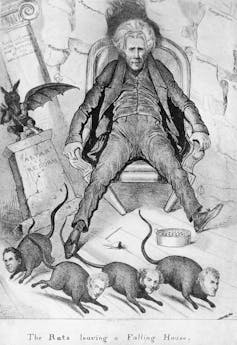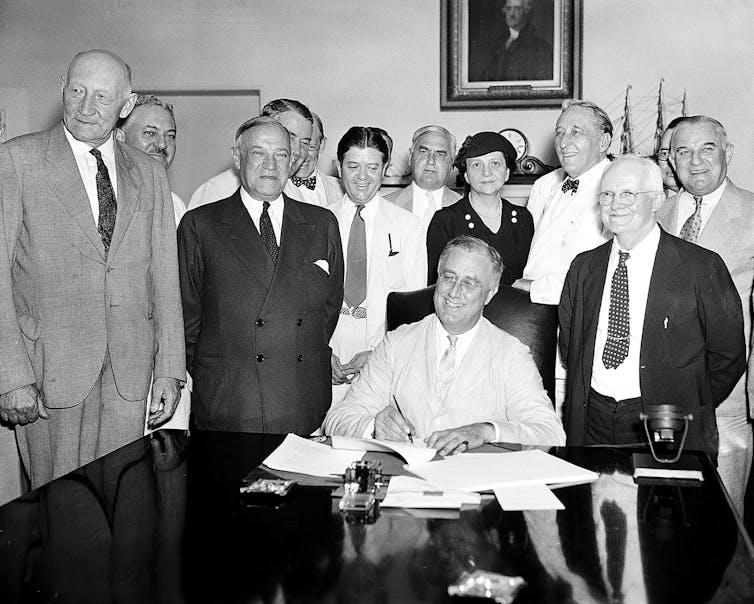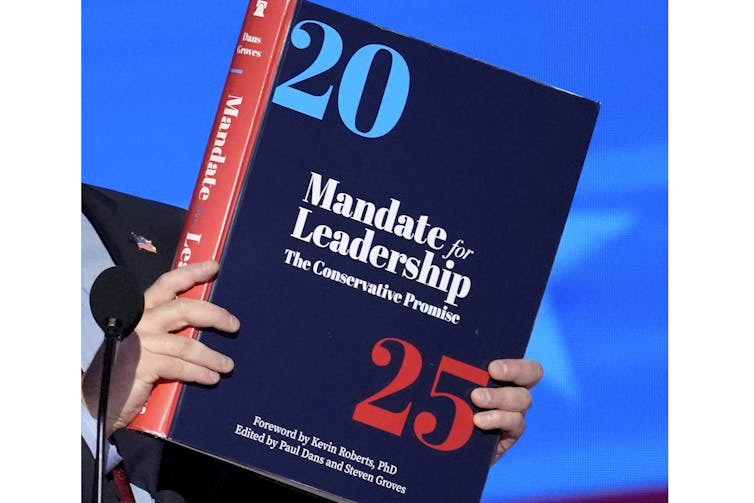
Kristen Grace/FLMNH, CC BY-SA
Stephanie Killingsworth, University of Florida and Bruce J. MacFadden, University of Florida
The ratios of strontium isotopes in fossil shark teeth can be used to better understand how coastal environments evolved in ancient times, according to our newly published work.
As paleontologists with the Florida Museum of Natural History, we’re interested in understanding ancient Florida environments.
Our study was one of the first to date Florida coastal deposits using fossil shark teeth and a technique that looks at variations in ocean strontium. Strontium is a chemical element that occurs naturally in rock, soil and water.
Ocean strontium values change over time, which makes measuring the levels of the chemical element a unique global system for determining the age of similar coastal sedimentary rock deposits worldwide.
Changes in strontium isotope ratios have multiple causes. Land erosion deposits strontium into oceans, while carbonate-producing marine life produce and release strontium when building their skeletons. Strontium is also released by deep-sea vents.
Geochemist Donald DePaolo and geologist B. Lynn Ingram discovered variations in ocean strontium by examining strontium isotopes ratios in marine sediments, including fossils. The levels of strontium isotopes in marine sediments provide a “time stamp” that correlates to the strontium value of the seawater at that time.
That data allowed scientists to map out ratios of strontium isotopes in seawater over time. This global strontium seawater curve correlates to the geologic timescale. Scientists use the curve to reconstruct past ocean chemistry and climate conditions, as well as the age of mollusks and other shell-producing marine fossils.
Why it matters
Properly dating ancient sites is key to understanding how Earth and its living creatures evolved over time.
But historically, strontium dating, while reliable, had limitations.
For example, it works best in fully marine environments and is challenging to use in fossil sites along coastlines. That’s because the strontium values might be influenced by land sediments and freshwater rivers.
Additionally, material used for strontium dating must not have undergone considerable physical and chemical change during fossilization, the preservation of once living things from the past. Any major chemical alteration to the fossil can affect the strontium value and give an inaccurate date.
Our study shows that fossil shark teeth are more resistant to these types of changes due to their outer enamel-like surface.
Remarkably, fossil shark teeth are also incredibly abundant. Sharks ruled the earth’s oceans for 400 million years, and every individual grows and sheds thousands of teeth in their lifetime.
How we did our work
Florida fossil sites are unique in that they possess some of the richest fossil sediments for important times in geologic history. These sites can help us understand changing climates, vegetation and sea levels over time.
The Florida Museum of Natural History has a collection of over 115,000 shark tooth specimens from Florida alone.
To do our study, we selected shark tooth specimens from two significant Neogene-period fossil sites in Florida. The Neogene, from 2.6 to 23.5 million years ago, was a time of immense change in biodiversity because of changing climates.
We analyzed the strontium present in powdered samples collected by shaving a thin layer from the surfaces of the teeth. The age of the teeth helped to clarify the age of the fossil sites where they were collected. This data enabled us to calibrate and differentiate the ages of our two sites, Montbrook and Palmetto Fauna Bone Valley, by about 600,000 years.
Before our study, scientists could estimate the age of the sites based only on mammal fossils. The sites were thought to be the same age. Our work provides a more precise date.
These ages offer new insights into what happened in the southeastern region of North America, some 5 million to 6 million years ago. Our revised age calibrations coincide with global events, including major sea-level fluctuations and the Great American Biotic Interchange – the migration of land mammals between North and South America after the formation of the Isthmus of Panama 4 million to 5 million years ago.
For example, because certain species of ground sloths are not found at the Montbrook site (5.85 million years old) but are found at the Palmetto Fauna Bone Valley site (5.22 million years old), it suggests the immigration of ground sloths into North America occurred between these two dates.
The Research Brief is a short take on interesting academic work.![]()
Stephanie Killingsworth, Ph.D. Student in Geological Sciences, University of Florida and Bruce J. MacFadden, Distinguished Professor Emeritus, University of Florida
This article is republished from The Conversation under a Creative Commons license. Read the original article.























































